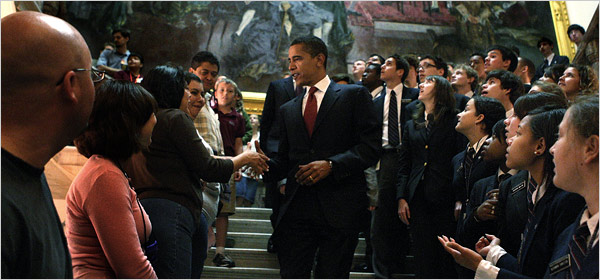|
Obama in his glory, 2008
As a follow-up to the previous entry, here is another look back in time to the way Obama was seen and portrayed before he became president. It is the opening part of an entry posted on May 9, 2008:
Caesar comes to the Capitol In its subtly mind-manipulating photographs conveying an alienated, leftist view of America, the New York Times is tops in the field, and its photo of the triumphant Barack Obama greeting people at the U.S. Capitol yesterday, by Doug Mills, is one of the Times’ best.
Note the artificially dim light, like one of those prime time TV dramas where all the scenes, including in courtrooms, hospitals, and the Oval Office, are in half darkness. Notice how virtually every person in the photo looks nonwhite. Notice how the photo centers on Obama, with all heads turned in unison toward him, giving him an image of mysterious power. In fact, it doesn’t even look like a photo of the United States of America. It looks like a photo of some nonwhite dictatorship. Which is what, in their heart of hearts, white liberals desire.
The readers’ comments in the entry are very interesting.
About the darkness in modern TV dramatic shows as a symptom of the liberal view of the universe: liberals did not always view the world in such a way. Compare the original and the newer Star Treks. The original Star Trek exemplified the now-extinct liberalism of the New Deal pre-Sixties consensus in its entire aesthetic, not just the message it incessantly preached. The lighting in the original Trek show was bright and clear in almost every scene, including and especially the crucial scenes on the bridge. The colours throughout were bright, solid primary colours, whether of the uniforms, the walls and floors of the ship, and almost every other object. The soundtrack, including the show’s really quite remarkably powerful and omnipresent incidental music, was clear and strong, sometimes sombre, elegiac, brooding, but always full of feeling. Even the characters’ voices seemed to be miked to be louder and clearer (to say nothing of the over-the-top performances, and not just by William Shatner). The general impression is one of energy and life, of an innocence and optimism almost devoid of self-doubt and self-consciousness.LA replies:
While I agree with your general point, I disagree on specifics. I do not remember that Star Trek: The Next Generation had the sort of dark lighting that became common in TV dramas and movies in the Nineties, in which the actors’ faces often couldn’t be made out. And I thought the actors in Star Trek: The Next Generation, other than the lead actor, were dead, with zero talent. Posted by Lawrence Auster at November 23, 2011 01:39 PM | Send Email entry |
